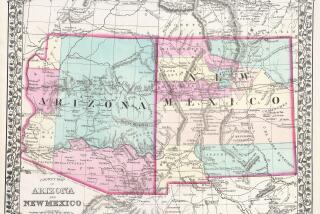California shouldn’t fall behind on license plate advertising
French novelist Victor Hugo is widely quoted as saying that there is “nothing as powerful as an idea whose time has come.” The time for advertising and sending messages to motorists traveling along California’s highways came long before I introduced SB 1453, which The Times pilloried in its July 9 editorial, “What’s wrong with this picture?”
Blinking, scrolling, flashing billboards already beam advertisements to passing motorists on California’s freeways. Vanity and environmental license plates tell motorists who you are, what you like and where you are from. Digital license plate frames that allow motorists to flash messages to drivers behind them can be purchased online for about $40.
It should come as no shock, then, that the idea of expanding the use of digital technology to the actual license plate itself has surfaced. California should not be late to the discussion of this emerging technology, whether it is used for public service or commercial messages. To this end, I introduced SB 1453, which authorizes the California Department of Motor Vehicles to investigate the functionality, safety and administrative applications of this technology and submit a report to the Legislature on the use of digital electronic license plates.
The idea was met with overwhelming support from my fellow legislators in the state Senate, who are fully aware that the language in the bill simply offers the option to research this technology. It will not cost the state a dime. In other words, this is a study bill.
In my presentation before the Assembly Transportation Committee, I expressed my concern that public safety should not in any way be compromised by the use of this proposed technology. I, too, have questions about this technology that I expect the study to answer.
However, this technology is coming of age, whether or not the government gets involved, and we are obligated to test it to see if it is appropriate for use on our roads. After all, California is the nation’s hub for technological innovation, representing the best of ideas and deliberative conversations around innovation and entrepreneurship. Our vanguard position in this regard has built the best public higher education system in the world, pioneering green technology and environmental protections, and cutting-edge high tech and biotech industries.
It is important to note that the proposed license plates would be installed only on cars whose drivers opt in; those who do so could choose which ads to display. The DMV would not decide what the drivers choose to advertise. However, the DMV would have the right to determine whether or not an ad is appropriate, which would certainly rule out the kind of inappropriate advertisements The Times’ editorial brings up. In addition, the plates’ ability to display Amber Alerts and traffic safety messages could provide an important public service.
As for law enforcement concerns, the plates would be designed so that when a member of law enforcement is within a certain distance of a vehicle, its plate would be triggered to only show the license number, temporarily disabling the ad feature. With regard to other important safety issues that I share with all drivers, the plates would be designed in a way that would not divert motorists’ attention from focusing on driving. The study will determine if this is feasible.
Most important, the plates would not flash advertisements or other messages while the vehicles are in motion or in stop-and-go traffic. The messages would display only after a car is parked or stopped for at least four seconds (or longer).
Contrary to The Times’ assertion that state senators showed “muddy” thinking by approving the bill to investigate this technology, I believe my colleagues’ support for SB 1453 stems from the Legislature’s understanding of the need to explore new technologies that can benefit the public and the private sector.
The market for our ideas, like this and others, can help lift us out of our economic slump. SB 1453 represents the kind of forward thinking desperately needed as the Legislature continues to battle a huge budget deficit that our governor intends to balance on the backs of the poor, the disabled and seniors — in other words, those who can least afford it. Now that is muddy thinking.
Democrat Curren D. Price Jr. represents California’s 26th state Senate district.
More to Read
Get the L.A. Times Politics newsletter
Deeply reported insights into legislation, politics and policy from Sacramento, Washington and beyond. In your inbox three times per week.
You may occasionally receive promotional content from the Los Angeles Times.






